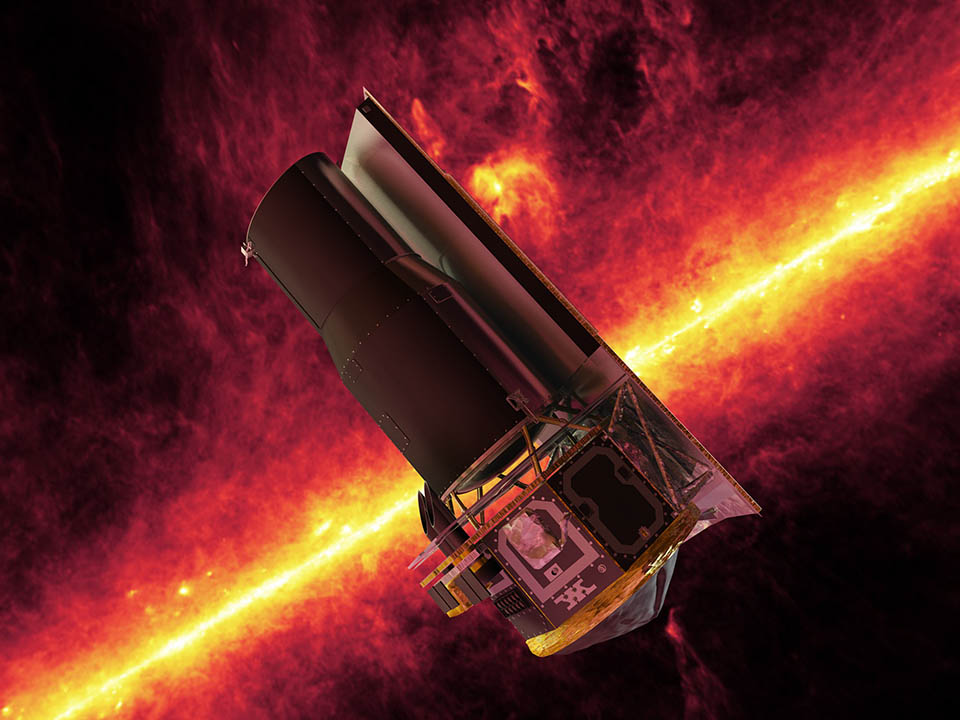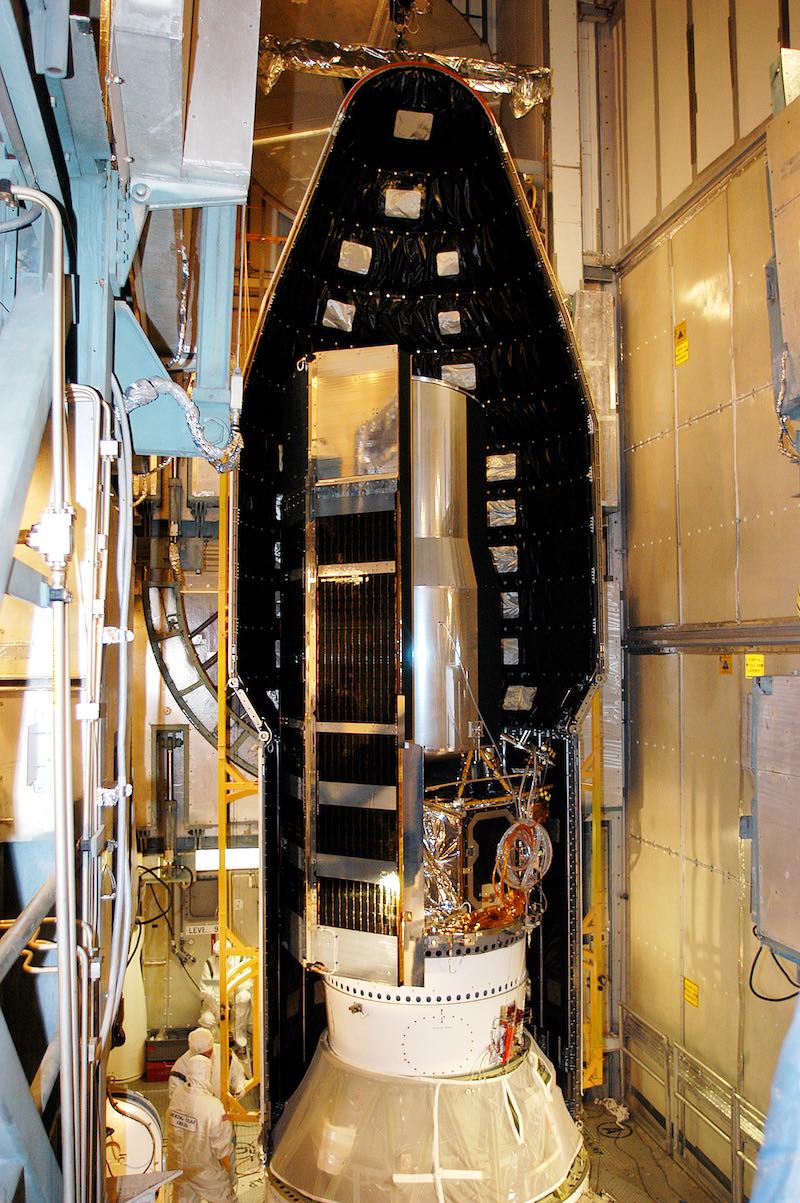
NASA declared the Spitzer Space Telescope’s 16-year mission complete Thursday after sending final commands for the spacecraft to enter hibernation as it drifts farther from Earth.
The Spitzer Space Telescope, one of NASA’s original four “Great Observatories,” studied the most distant galaxy ever observed in the universe, gathered data on the characteristics of planets around other stars, and detected a new ring around Saturn. Among other discoveries, Spitzer also provided astronomers with new insights into star formation and interstellar dust, the scattered diffuse material between the stars.
Sensitive to infrared light, Spitzer operated more than 16 years since its launch in August 2003. The observatory orbits the sun on a trajectory similar to Earth’s, but Spitzer takes a bit longer to complete one lap of the sun, and is getting farther from Earth.
Spitzer is currently around 160 million miles (260 million kilometers) from Earth, and NASA says communication with the observatory is getting more difficult. Spitzer outlived its original minimum mission lifetime of two-and-a-half years.
“Spitzer has taught us about entirely new aspects of the cosmos and taken us many steps further in understanding how the universe works, addressing questions about our origins, and whether or not are we alone,” said Thomas Zurbuchen, associate administrator of NASA’s Science Mission Directorate in Washington. “This Great Observatory has also identified some important and new questions and tantalizing objects for further study, mapping a path for future investigations to follow. Its immense impact on science certainly will last well beyond the end of its mission.”
Joseph Hunt, Spitzer’s project manager at NASA’s Jet Propulsion Laboratory in Pasadena, California, declared the spacecraft decommissioned and Spitzer’s mission complete at 5:34 p.m. PST (2:34 p.m. PST; 2234 GMT) Thursday.
“It was really an exceptional event,” Hunt told Spaceflight Now in an interview. “I was very proud of the team, how we rehearsed, how we planned, how we had everything scripted out. We even planned for some off-nominal activities that could occur, which they did not.”

Ground teams at JPL uplinked a command to Spitzer through NASA’s Deep Space Network station in Goldstone, California, for the spacecraft to enter safe mode. The command put Spitzer in a “sun-coning” attitude that keeps sunlight on the spacecraft’s power-generating solar arrays.
Controllers at JPL saw the radio signal strength drop as Spitzer properly responded to the safe mode command.
Hunt said the faint carrier radio signal from Spitzer “will continue as long as the spacecraft does not have some kind of anomaly on-board.”
“This signal will continue to reduce in strength because we continue to recede away from Earth,” Hunt said. “In about 2053, we will come back past the Earth. We’ll be nine times the distance from the Earth to the moon, and we’ll head back out in the opposite direction. The signal is very weak, and it would take a special ground receiver to actually acquire the signal, and a special team of people and some special hardware to do that.”
The Spitzer observatory shot into space Aug. 25, 2003, with a middle-of-the-night launch aboard a Delta 2 rocket from Cape Canaveral.
observations with Spitzer after a review by senior scientists in 2016 ranked the mission at the bottom of a list of six astrophysics missions reviewed by the independent panel. NASA uses the senior review reports to prioritize spending on extended missions, in balance with expenditures to design, develop and build new astrophysics probes and telescopes.
“In 2016, we looked ahead and saw the upcoming launch of the James Webb Space Telescope, NASA’s next great observatory, which is also an infrared observatory, and the decision was made that the Spitzer mission should end as the James Webb mission was beginning,” said Paul Hertz, director of NASA’s astrophysics division.
“At the time, we extended the Spitzer mission all the way through the launch of James Webb in 2018,” Hertz told reporters last week. “When the James Webb launch was delayed until 2021, we extended Spitzer until now, in 2020, but the time has come for the Spitzer mission to end as we move on to the launch of James Webb next year.”
NASA announced last year its intention to end the Spitzer mission in early 2020, after searches for private funding sources to continue Spitzer operations turned up empty.
Thomas Zurbuchen, head of NASA’s science division, said last May that NASA followed guidance from the senior review in deciding when to shut down Spitzer.
“Every once in a while, that means that we turn off a mission because the science return is no longer warranting keeping it going in the context of the other missions,” Zurbuchen said last year. “It’s not that there’s no science return, but there’s less.”
Spitzer cost $11 million to operate in fiscal year 2018, a reduction from Spitzer’s $17 million budget in 2014. Spitzer escaped cancellation in 2014 after project managers found ways to reduce the mission’s operating costs.

The mission that became the Spitzer Space Telescope started development in the 1980s. NASA asked scientists in 1983 to propose instruments for a infrared telescope to fly on the space shuttle, a project then known as the Shuttle Infrared Space Facility.
But the success of the first space-based infrared observatory — the Infrared Astronomical Satellite — galvanized support for a larger free-flying infrared mission. In 1984, NASA selected astronomers to develop plans and build instruments for a standalone mission named the Space Infrared Telescope Facility, or SIRTF.
The SIRTF mission was the last of NASA’s four original “Great Observatories” to launch, following Hubble, the Compton Gamma Ray Observatory, and Chandra. But Spitzer was the only one of the four not to launch on the space shuttle, and NASA downsized the mission due to funding limitations.
After its launch in 2003, NASA named the telescope for Lyman Spitzer, a 20th century astrophysicist who was the first person to propose putting a large observatory in space, according to NASA.
Built by Lockheed Martin, Spitzer weighed nearly one ton when it launched in 2003, and the spacecraft measures 14.6 feet (4.45 meters) long and 6.9 feet (2.1 meters) in diameter. Spitzer is about one-third as long as the larger Hubble Space Telescope, and one-eleventh the width, allowing it to launch on a Delta 2 rocket instead of the space shuttle, which hauled Hubble into orbit.
The primary mirror on the Spitzer telescope is about 33.5 inches (85 centimeters) in diameter, reflecting starlight onto an array of thousands of individual detectors tuned to be sensitive to infrared radiation.
Ball Aerospace supplied instruments and the telescope structure for Spitzer.

Spitzer launched with a supply of super-cold liquid helium to cool its most sensitive infrared detectors, which were designed to image some of the coldest reaches of the universe. Since 2009, when Spitzer ran out of cryogenic helium, the telescope has only been able to use two of its shorter wavelength imaging bands in one of the observatory’s three instruments. Detectors in the near-infrared bands did not need to be chilled to do their work.
Infrared telescopes are sensitive to thermal energy, or heat, rather than visible light. That means telescopes like Spitzer can see through veils of dust and gas, and peer deep into the cosmos to detect some of the coldest, most distant objects in the universe.
“I think that Spitzer is an example of the very best that people can achieve,” said Michael Werner, Spitzer’s project scientist. “I feel very fortunate to have worked on this mission, and to have seen the ingenuity, doggedness and brilliance that people on the team showed. When you tap into those things and empower people to use them, then truly incredible things will happen.”
“The Spitzer Space Telescope has unveiled the infrared universe,” said Farisa Morales, an astrophysicist at NASA’s Jet Propulsion Laboratory. It has allowed us to see what our human eyes could not see … These these huge molecular clouds in our galaxy, which are stellar nurseries, become transparent when you’re observing in infrared radiation, and it allows us to see these baby stars forming.”
And (in) the process of forming a star, some of the debris is left over to form planetary systems,” Morales said. “Spitzer has been a pathfinder in allowing us to find out which ones are forming now for future exploration.”
Astronomers used Spitzer to determine the chemical composition of dust and material around other stars.
“When you analyze through spectroscopy, you can obtain the chemical composition of the dust orbiting another star,” Morales said. “And you can also get information about the structure of, for example, other planetary systems that are forming. So it’s amazing how data can be studied and how much information that brings us.”
Spitzer and Hubble observed the farthest galaxy ever seen in the universe, a collection of ancient stars located around 13.4 billion light-years away. Spitzer and Hubble saw the galaxy as it was just 400 million years after the Big Bang, when the universe was around 5 percent of its current age.
Other landmark findings by Spitzer include the discovery of a previously unseen ring around Saturn, and the analysis of a cloud of dust blown off Comet Tempel 1 in 2005, when NASA’s Deep Impact spacecraft intentionally drove into the comet to shed light on its icy interior.
Spitzer discovered five of the seven known Earth-sized planets in the TRAPPIST-1 planetary system around a star 40 light-years, or about 235 trillion miles (378 trillion kilometers), from Earth. The TRAPPIST-1 system holds the record for the most Earth-sized planets around a single star outside our solar system.
Spitzer’s mission cost around $1.36 billion from the start of full-scale development through the end of the observatory’s operations phase, according to Hertz.
The James Webb Space Telescope scheduled to launch in 2021 and the Wide Field Infrared Survey Telescope planned for launch in 2025 will build upon Spitzer’s mission.
“The James Webb mirror is 50 times larger than the Spitzer’s mirror, so we’ll be able to observe even deeper into the universe,” Hertz said. “In fact, James Webb is designed to detect the first light after the Big Bang, the first stars and the first galaxies. And even beyond that, were we’ve started building the Wide Field Infrared Survey Telescope , WFIRST, which will be the great observatory to follow Webb.
“WFIRST has the sensitivity of Hubble but 100 times the field of view,” Hertz said. “So with every WFIRST image we’ll be doing 100 Hubble Deep fields. So we are well positioned to continue studying the universe in infrared, and the gap of a year or so really is not a concern.
Email the author.
Follow Stephen Clark on Twitter: @StephenClark1.



